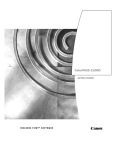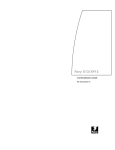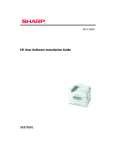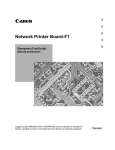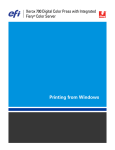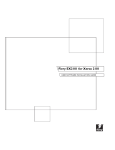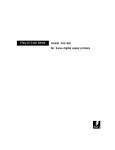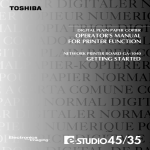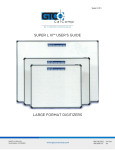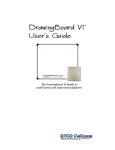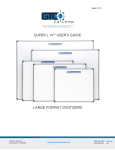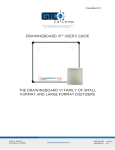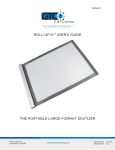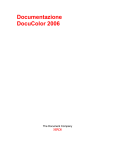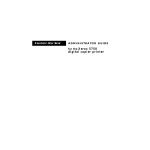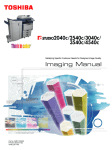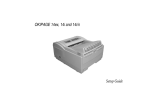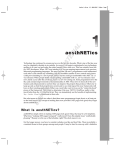Download Xerox DocuColor 40CP User's Manual
Transcript
Getting Started DOCUCOLOR 40 CP Copyright © 1998 Electronics for Imaging, Inc. All rights reserved. This publication is protected by copyright, and all rights are reserved. No part of it may be reproduced or transmitted in any form or by any means for any purpose without express prior written consent from Electronics for Imaging, Inc., except as expressly permitted herein. Information in this document is subject to change without notice and does not represent a commitment on the part of Electronics for Imaging, Inc. The software described in this publication is furnished under license and may only be used or copied in accordance with the terms of such license. Patents: 5,666,436; 5,553,200; 5,543,940; 5,537,516; 5,517,334; 5,506,946; 5,424,754; 5,343,311; 5,212,546; 4,941,038; 4,837,722; 4,500,919 Trademarks EFI, the EFI logo, Fiery, the Fiery logo, EFICOLOR, and Rip-While-Print are trademarks registered in the U.S. Patent and Trademark Office. Fiery ZX, Fiery X2, Command WorkStation, AutoCal, Starr Compression, Memory Multiplier, ColorWise, NetWise, and VisualCal are trademarks of Electronics for Imaging, Inc. DocuColor and all Xerox product names mentioned in this publication are trademarks of the XEROX CORPORATION. Adobe, the Adobe logo, Adobe Illustrator, PostScript, Adobe Photoshop, Adobe Separator, and Adobe PageMaker are trademarks of Adobe Systems Incorporated, registered in certain jurisdictions. EPS (Encapsulated PostScript) is a trademark of Altsys Corporation. Apple, the Apple logo, AppleShare, AppleTalk, EtherTalk, LaserWriter, and Macintosh are registered trademarks, and MultiFinder is a trademark of Apple Computer, Inc. Microsoft, MS, MS-DOS, and Windows are registered trademarks of Microsoft in the US and other countries. QuarkXPress is a registered trademark of Quark, Inc. Times, Helvetica, and Palatino are trademarks of Linotype AG and/or its subsidiaries. ITC Avant Garde, ITC Bookman, ITC Zapf Chancery, and ITC Zapf Dingbats are registered trademarks of International Typeface Corporation. Ethernet is a registered trademark of Xerox Corporation. Farallon, PhoneNET PC, and PhoneNET Talk are trademarks of Farallon Computing, Inc. COPS and COPSTalk are trademarks of CoOperative Printing Solutions, Inc. NetWare and Novell are registered trademarks and Internetwork Packet Exchange (IPX) is a trademark of Novell, Inc. SyQuest is a registered trademark, in the United States and certain other countries, of SyQuest Technology, Inc. UNIX is a registered trademark of UNIX System Laboratories, a wholly owned subsidiary of Novell, Inc. PANTONE is a registered trademark of Pantone, Inc. All other terms and product names may be trademarks or registered trademarks of their respective owners, and are hereby acknowledged. Legal Notices APPLE COMPUTER, INC. (“APPLE”) MAKES NO WARRANTIES, EXPRESS OR IMPLIED, INCLUDING WITHOUT LIMITATION THE IMPLIED WARRANTIES OF MERCHANTABILITY AND FITNESS FOR A PARTICULAR PURPOSE, REGARDING THE APPLE SOFTWARE. APPLE DOES NOT WARRANT, GUARANTEE, OR MAKE ANY REPRESENTATIONS REGARDING THE USE OR THE RESULTS OF THE USE OF THE APPLE SOFTWARE IN TERMS OF ITS CORRECTNESS, ACCURACY, RELIABILITY, CURRENTNESS, OR OTHERWISE. THE ENTIRE RISK AS TO THE RESULTS AND PERFORMANCE OF THE APPLE SOFTWARE IS ASSUMED BY YOU. THE EXCLUSION OF IMPLIED WARRANTIES IS NOT PERMITTED BY SOME STATES. THE ABOVE EXCLUSION MAY NOT APPLY TO YOU. IN NO EVENT WILL APPLE, ITS DIRECTORS, OFFICERS, EMPLOYEES OR AGENTS BE LIABLE TO YOU FOR ANY CONSEQUENTIAL, INCIDENTAL OR INDIRECT DAMAGES (INCLUDING DAMAGES FOR LOSS OF BUSINESS PROFITS, BUSINESS INTERRUPTION, LOSS OF BUSINESS INFORMATION, AND THE LIKE) ARISING OUT OF THE USE OR INABILITY TO USE THE APPLE SOFTWARE EVEN IF APPLE HAS BEEN ADVISED OF THE POSSIBILITY OF SUCH DAMAGES. BECAUSE SOME STATES DO NOT ALLOW THE EXCLUSION OR LIMITATION OF LIABILITY FOR CONSEQUENTIAL OR INCIDENTAL DAMAGES, THE ABOVE LIMITATIONS MAY NOT APPLY TO YOU. Apple’s liability to you for actual damages from any cause whatsoever, and regardless of the form of the action (whether in contract, tort [including negligence], product liability or otherwise), will be limited to $50. Restricted Rights Legends For defense agencies: Restricted Rights Legend. Use, reproduction, or disclosure is subject to restrictions set forth in subparagraph (c)(1)(ii) of the Rights in Technical Data and Computer Software clause at 252.227.7013. For civilian agencies: Restricted Rights Legend. Use, reproduction, or disclosure is subject to restrictions set forth in subparagraph (a) through (d) of the commercial Computer Software Restricted Rights clause at 52.227-19 and the limitations set forth in Electronics for Imaging, Inc.’s standard commercial agreement for this software. Unpublished rights reserved under the copyright laws of the United States. Printed in the United States of America on recycled paper. Part Number: n/a CE Mark The CE marking applied to this product symbolises Rank Xerox’s declaration of conformity with the following applicable directives of the European Union as of the dates indicated. January 1, 1996—Council Directive 70/80/CCO amended by Council Directive 93/68/EEO. Approximation of the laws of the member states related to low voltage equipment. January 1, 1996—Council Directive 59/336/EEC. Approximation of the laws of the member states related to electromagnetic compatibility. A full declaration defining the relevant directives and referenced standards can be obtained from your Rank Xerox representative. WARNING: In order to allow this equipment to operate in proximity to industrial, scientific, and Medical (ISM) equipment, the external radiation from ISM equipment may have to be limited or special migration measures taken. WARNING: This is a Class A product. In a domestic environment this product may cause radio interference, in which case the user may be required to take adequate measures. FCC Information WARNING: FCC Regulations state that any unauthorized changes or modifications to this equipment not expressly approved by the manufacturer could void the user’s authority to operate this equipment. NOTE: This equipment has been tested and found to comply with the limits for a Class A digital device, pursuant to Part 15 of the FCC Rules. These limits are designed to provide reasonable protection against harmful interference when the equipment is operated in a commercial environment. This equipment generates, and uses, and can radiate radio frequency energy and, if not installed and used in accordance with the instruction manual, may cause harmful interference to radio communications. Operation of this equipment in a residential area is likely to cause interference in which case the user will be required to correct the interference at his own expense. Industry Canada Class A Notice This digital apparatus does not exceed the Class A limits for radio noise emissions from digital apparatus as set out in the interference-causing equipment standard entitled, “Digital Apparatus” ICES-003 from Industry Canada. Avis de Conformation Classe A d l’Industrie Canada Le présent appareil numérique n’émet pas de bruits radioélectriques dépassant les limites applicables aux appareils numériques de la Classe A prescrites dans la norme sur le matériel brouilleur, “Appareils Numériques” NMB-003 édictée par l’Industrie Canada. Certificate by Manufacturer/Importer This is to certify that the FC07 is shielded against radio interference in accordance with the provisions of VFG 243/1991. The German Postal Services have been advised that this device is being put on the market and that they have been given the right to inspect the series for compliance with the regulations. Electronics for Imaging, Inc. Bescheinigung des Herstellers/Importeurs Heirmit wird bescheinigt, dass der FC07 im Uebereinstimmung mit den Bestimmungen der VFG 243/1991 Funk-Entstort ist. Der Deutschen Bundespost wurde das Inverkehrbringen dieses Geraetes angezeigt und die Berechtigung zur Ueberpruefung der Serie auf Einhaltung der Bestimmungen eingeraumt. Electronics for Imaging, Inc. RFI Compliance Notice This equipment has been tested concerning compliance with the relevant RFI protection requirements both individually and on system level (to simulate normal operation conditions). However, it is possible that these RFI Requirements are not met under certain unfavorable conditions in other installations. It is the user who is responsible for compliance of his particular installation. Dieses Geraet wurde einzeln sowohl als auch in einer Anlage, die einen normalen Anwendungsfall nachbildet, auf die Einhaltung der Funk-entstoerbestimmungen geprueft. Es ist jedoch moeglich, dass die Funk-enstoerbestimmungen unter unguenstigen Umstaenden bei anderen Geraetekombinationen nicht eingehalten werden. Fuer die Einhaltung der Funk-entstoerbestimmungen seigner gesamten Anlage, in der dieses Geraet betrieben wird, ist der Betreiber verantwortlich. Compliance with applicable regulations depends on the use of shielded cables. It is the user who is responsible for procuring the appropriate cables. Einhaltung mit betreffenden Bestimmungen kommt darauf an, dass geschirmte Ausfuhrungen gebraucht werden. Fuer die beschaffung richtiger Ausfuhrungen ist der Betreiber verantwortlich. Software License Agreement Before using the Software, please carefully read the following terms and conditions. BY USING THIS SOFTWARE, YOU SIGNIFY THAT YOU HAVE ACCEPTED THE TERMS OF THIS AGREEMENT. If you cannot or do not accept these terms, you may return the entire package within ten (10) days to the Distributor or Dealer from which you obtained them for a full refund. Electronics for Imaging, Inc. grants to you a non-exclusive, non-transferable license to use the software and accompanying documentation (“Software”) included with the DocuColor 40 CP you have purchased, including without limitation the PostScript® software provided by Adobe Systems Incorporated. You may: a. use the Software solely for your own customary business purposes and solely with DocuColor 40 CP; b. use the digitally-encoded machine-readable outline and bitmap programs (“Font Programs”) provided with DocuColor 40 CP in a special encrypted format (“Coded Font Programs”) to reproduce and display designs, styles, weights, and versions of letters, numerals, characters and symbols (“Typefaces”) solely for your own customary business purposes on the display window of the DocuColor 40 CP or monitor used with DocuColor 40 CP; c. use the trademarks used by Electronics for Imaging to identify the Coded Font Programs and Typefaces reproduced therefrom (“Trademarks”); and d. assign your rights under this Agreement to a transferee of all of your right, title and interest in and to DocuColor 40 CP provided the transferee agrees to be bound by all of the terms and conditions of this Agreement. You may not: a. make use of the Software, directly or indirectly, to print bitmap images with print resolutions of 600 dots per inch or greater, or to generate fonts or typefaces for use other than with DocuColor 40 CP; b. make or have made, or permit to be made, any copies of the Software, Coded Font Programs, accompanying documentation or portions thereof, except as necessary for use with the DocuColor 40 CP unit purchased by you; provided, however, that under no circumstances may you make or have made, or permit to be made, any copies of that certain portion of the Software which has been included on the DocuColor 40 CP hard disk drive. You may not copy the documentation; c. attempt to alter, disassemble, decrypt or reverse engineer the Software, Coded Font Programs or accompanying documentation. d. rent or lease the Software. Proprietary Rights You acknowledge that the Software, Coded Font Programs, Typefaces, Trademarks and accompanying documentation are proprietary to Electronics for Imaging and its suppliers and that title and other intellectual property rights therein remain with Electronics for Imaging and its suppliers. Except as stated above, this Agreement does not grant you any right to patents, copyrights, trade secrets, trademarks (whether registered or unregistered), or any other rights, franchises or licenses in respect of the Software, Coded Font Programs, Typefaces, Trademarks or accompanying documentation. You may not adapt or use any trademark or trade name which is likely to be similar to or confusing with that of Electronics for Imaging or any of its suppliers or take any other action which impairs or reduces the trademark rights of Electronics for Imaging or its suppliers. The trademarks may only be used to identify printed output produced by the Coded Font Programs. At the reasonable request of Electronics for Imaging, you must supply samples of any Typeface identified with a trademark. Confidentiality You agree to hold the Software and Coded Font Programs in confidence, disclosing the Software and Coded Font Programs only to authorized users having a need to use the Software and Coded Font Programs as permitted by this Agreement and to take all reasonable precautions to prevent disclosure to other parties. Remedies Unauthorized use, copying or disclosure of the Software, Coded Font Programs, Typefaces, Trademarks or accompanying documentation will result in automatic termination of this license and will make available to Electronics for Imaging other legal remedies. Limited Warranty And Disclaimer Electronics for Imaging warrants that, for a period of ninety (90) days from the date of delivery to you, the Software under normal use will perform without significant errors that make it unusable. Electronics for Imaging’s entire liability and your exclusive remedy under this warranty (which is subject to you returning DocuColor 40 CP to Electronics for Imaging or an authorized dealer) will be, at Electronics for Imaging’s option, to use reasonable commercial efforts to attempt to correct or work around errors, to replace the Software with functionally equivalent software, or to refund the purchase price and terminate this Agreement. Some states do not allow limitations on duration of implied warranty, so the above limitation may not apply to you. Except for the above express limited warranty, Electronics for Imaging makes and you receive no warranties or conditions on the Products, express, implied, or statutory, and Electronics for Imaging specifically disclaims any implied warranty or condition of merchantability or fitness for a particular purpose. For warranty service, please contact your authorized service/support center. EXCEPT FOR THE ABOVE EXPRESS LIMITED WARRANTY, ELECTRONICS FOR IMAGING MAKES AND YOU RECEIVE NO WARRANTIES OR CONDITIONS ON THE SOFTWARE OR CODED FONT PROGRAMS, EXPRESS, IMPLIED, STATUTORY, OR IN ANY OTHER PROVISION OF THIS AGREEMENT OR COMMUNICATION WITH YOU, AND ELECTRONICS FOR IMAGING SPECIFICALLY DISCLAIMS ANY IMPLIED WARRANTY OR CONDITION OF MERCHANTABILITY OR FITNESS FOR A PARTICULAR PURPOSE. Electronics for Imaging does not warrant that the operation of the software will be uninterrupted or error free or that the Software will meet your specific requirements. Limitation Of Liability IN NO EVENT WILL ELECTRONICS FOR IMAGING OR ITS SUPPLIERS BE LIABLE FOR ANY DAMAGES, INCLUDING LOSS OF DATA, LOST PROFITS, COST OF COVER OR OTHER SPECIAL, INCIDENTAL, CONSEQUENTIAL OR INDIRECT DAMAGES ARISING FROM THE USE OF THE SOFTWARE, CODED FONT PROGRAMS OR ACCOMPANYING DOCUMENTATION, HOWEVER CAUSED AND ON ANY THEORY OF LIABILITY. THIS LIMITATION WILL APPLY EVEN IF ELECTRONICS FOR IMAGING OR ANY AUTHORIZED DEALER HAS BEEN ADVISED OF THE POSSIBILITY OF SUCH DAMAGE. YOU ACKNOWLEDGE THAT THE PRICE OF THE UNIT REFLECTS THIS ALLOCATION OF RISK. BECAUSE SOME STATES/JURISDICTIONS DO NOT ALLOW THE EXCLUSION OR LIMITATION OF LIABILITY FOR CONSEQUENTIAL OR INCIDENTAL DAMAGES, THE ABOVE LIMITATION MAY NOT APPLY TO YOU. Export Controls You agree that you will not export or re-export the Software or Coded Font Programs in any form without the appropriate United States and foreign government licenses. Your failure to comply with this provision is a material breach of this Agreement. Government Use Use, duplication or disclosure of the Software by the United States Government is subject to restrictions as set forth in subdivision (c) (1) (ii) of the Rights in Technical Data and Computer Software clause at DFARS 252.227-7013 or in subparagraphs (c) (1) and (2) of the Commercial Computer Software—Restricted Right Clause at 48 CFR 52.227-19, as applicable. Third Party Beneficiary You are hereby notified that Adobe Systems Incorporated, a California corporation located at 345 Park Avenue, San Jose, CA 95110-2704 (“Adobe”) is a thirdparty beneficiary to this Agreement to the extent that this Agreement contains provisions which relate to your use of the Fonts, the Coded Font Programs, the Typefaces and the Trademarks licensed hereby. Such provisions are made expressly for the benefit of Adobe and are enforceable by Adobe in addition to Electronics for Imaging. General This Agreement will be governed by the laws of the State of California. This Agreement is the entire agreement held between us and supersedes any other communications or advertising with respect to the Software, Coded Font Programs and accompanying documentation. If any provision of this Agreement is held invalid, the remainder of this Agreement shall continue in full force and effect. If you have any questions concerning this Agreement, please write to Electronics for Imaging, Inc., Attn: Licensing Dept. or see Electronics for Imaging’s web site at www.efi.com. Electronics for Imaging, Inc. 2855 Campus Drive San Mateo, CA 94403 Contents Introduction About the documentation ix Specifications x User software xi System requirements xii Windows xii Mac OS xiv UNIX (TCP/IP) xiv Parallel port xv IPX (Novell) xv Installing User Software on a Windows Computer Installing Windows software 1 Downloading printer files with the Installer WebTool 2 Setting up the DocuColor 40 CP as a PostScript printer 2 Setting up PostScript printing with Windows 95 2 Setting up PostScript printing with Windows 3.1x 17 Setting up PostScript printing with Windows NT 4.0 22 Installing DocuColor 40 CP software 34 Downloader and Print Calibrator 35 Using the software for the first time 36 Configuring the connection to the server 36 Copying color files from the User Software CD 39 Installing the DocuColor 40 CP ICM printer profile for Windows 95 40 Installing files for Adobe Photoshop 41 viii Table of Contents Installing User Software on a Mac OS Computer Installing Mac OS software 45 Downloading printer files with the Installer WebTool 46 Setting up PostScript printing with Mac OS 46 Setting up the DocuColor 40 CP in the Chooser 47 Installing DocuColor 40 CP software and fonts 49 Screen fonts 51 Copying color files from the User Software CD 52 Installing files for Adobe Photoshop 53 Downloading Installers with WebTools Setting up WebTools 57 Using the Installer WebTool 58 Troubleshooting On a Windows computer 61 Setting up IPX (Novell) printing for Windows NT Workstation 61 Installing the Adobe PostScript Printer Driver 61 Problems with the DocuColor utilities on Windows 95 or Windows NT 61 On a Mac OS computer 62 Setting up the DocuColor 40 CP in the Chooser 62 Installing screen fonts 62 Index ix Introduction About the documentation This manual describes how to install the user software for the DocuColor 40 CP Color Server™ and set up printing from Windows and Mac OS computers. For information about setting up network servers and clients to use the DocuColor 40 CP Color Server, see the Configuration Guide. For general information on using the color copier, your computer, your application software, or your network, see the manuals that accompany those products. Your DocuColor 40 CP includes a media pack containing: • User Software CD • System Software CD • User Documentation CD • Printed Release Notes (described below) • Quick Start Notes About the documentation This manual is part of the set of DocuColor 40 CP documentation, which includes the following manuals for users and system administrators: • The Configuration Guide explains basic configuration and administration of the DocuColor 40 CP for the supported platforms and network environments. It also includes guidelines for setting up UNIX, Windows NT, and NetWare servers to provide PostScript printing services to clients. • Getting Started describes how to install software to enable users to print to the DocuColor 40 CP. Specifically, it describes installation of PostScript printer drivers, printer description files, and other software provided on the User Software CD. It also explains how to connect networked client workstations to the DocuColor 40 CP for printing and client utility use. • The Printing Guide describes the printing features of the DocuColor 40 CP for users who send jobs via remote workstations on the network or via a direct parallel port connection. x Introduction • The Color Guide provides an introduction to the basics of color theory and printing to a DocuColor 40 CP Color Server. It also includes practical color printing tips and application notes that explain how to print to the DocuColor 40 CP from popular Windows and Mac OS applications. • The Job Management Guide explains the functions of the DocuColor utilities and WebTools, and how they can be used to manage jobs and maintain color quality. This book is intended for an operator or administrator, or a user with the necessary access privileges, who needs to monitor and manage job flow, perform color calibration, and troubleshoot problems that may arise. • Release Notes provide last-minute product information and workarounds for some of the problems you may encounter. Specifications The DocuColor 40 CP has the following features: • MIPS R5000, 200 MHz CPU • 128MB RAM (upgrade to 512MB available as an optional kit) • Internal 4GB hard disk drive • External 12x CD-ROM drive • SCSI port • Supports AppleTalk, TCP/IP, and IPX protocols simultaneously • Supports parallel port communication • Supports thinnet (thin coaxial Ethernet cable or 10Base2), thicknet (thick coaxial Ethernet cable or 10Base5), and unshielded twisted pair (Fast Ethernet 100BaseTX or Ethernet 10BaseT) • Supports Token Ring networking (available as an optional kit) • Supports Adobe PostScript 3 • Includes 136 fonts (117 Adobe Type 1 PostScript and 19 TrueType) In addition, two Adobe Multiple Master fonts are included and are used for font substitution in PDF files. • Built-in ColorWise™ color management and NetWise™ networking features xi User software • WebTools™ • Downloader™ and Print Calibrator™ client utilities User software The full set of DocuColor 40 CP user software is provided on the User Software CD. Installers for the printer files can also be downloaded with the Installer WebTool (see page 58). Adobe PostScript Printer Driver Enables you to print to the DocuColor 40 CP from Windows NT 4.0, Windows 3.1x, Windows 95, and Mac OS computers; supports special DocuColor 40 CP and PostScript 3 features. PostScript Printer Description Files for use with the PostScript printer driver; they files (PPDs) allow the DocuColor 40 CP to appear in popular applications’ Print and Page Setup dialog boxes. The DocuColor 40 CP PPDs provide information about the DocuColor 40 CP and your particular copier model to the application and printer driver you are using. PostScript Screen Fonts Screen fonts for the 136 printer fonts installed on the DocuColor 40 CP (117 Adobe Type 1 and 19 TrueType). See Appendix B of the Printing Guide for a complete list. Downloader Enables you to print PostScript files, Encapsulated PostScript (EPS) files, and Portable Document Format (PDF) files directly to the DocuColor 40 CP without opening the application in which they were created. Downloader also enables you to manage the printer fonts installed on the DocuColor 40 CP. xii Introduction Print Calibrator Enables you to calibrate the DocuColor 40 CP remotely from a Windows 95, Windows NT 4.0, or Mac OS computer. Proper calibration keeps color consistent across time. Also allows you to create custom calibration and simulation targets. Color management files ColorSync and ICM color management files that enable you to maintain consistent color from your original artwork to the colors displayed on your monitor to the printed output. Color reference files Reference pages that you can print to view the range of colors available on your DocuColor 40 CP. For the most predictable color results, refer to these pages when defining colors in applications. System requirements To install the DocuColor 40 CP user software on a Windows or Mac OS computer, the computer must be equipped with a built-in or external CD-ROM drive. Windows To print to the DocuColor 40 CP, you need: • A Windows-based computer with an 80486, AMD, or Pentium processor • Windows 95, Windows 3.1x, or Windows NT 4.0 • At least 4MB of RAM To use the DocuColor utilities (Downloader and Print Calibrator) you also need: • Either Windows 95 or Windows NT 4.0 with NT Service Pack 3 • At least 16MB of RAM xiii System requirements To use WebTools, you also need: • Either Netscape Communicator v4.0.4 with Java enabled or Microsoft Internet Explorer v3.0.2 with Java enabled N OTE : Netscape and Microsoft continue to release frequent updates to their browsers. As support cannot be guaranteed for all versions, use the versions specified above for best results. • A monitor that supports 16-bit color at a minimum resolution of 800 x 600 • A TCP/IP enabled network and the IP address or DNS name of the DocuColor 40 CP • Web Services enabled on the DocuColor 40 CP N OTE : DocuColor utilities and WebTools are not supported with Windows 3.1x or over IPX (Novell) or IPX/SPX networks. With Microsoft Windows 95, you also need: • IPX/SPX or TCP/IP networking protocol installed • Adobe PostScript Printer Driver for Windows version 4.2 or later (version 4.2.2 is included with the user software) With Microsoft Windows 3.1x, you also need: • IPX networking protocol installed • IPX/SPX networking software for IPX/SPX communication • MS-DOS version 5.0 or later • Adobe PostScript Printer Driver for Windows version 3.0 or later (version 3.1.2 is included with the user software) With Microsoft Windows NT 4.0 you also need: • TCP/IP or AppleTalk networking protocol installed • Adobe PostScript Printer Driver for Windows version 5.0 (included with the user software) xiv Introduction Mac OS To print to the DocuColor 40 CP, you need: • A Mac OS-based computer • At least 8MB of RAM • EtherTalk installed • Apple System software version 7.5 or later • Adobe PostScript Printer Driver version 8.5 or later (version 8.5.1 is included with the user software) To use the DocuColor utilities (Downloader and Print Calibrator), you also need: • A Power Macintosh computer • At least 16MB of RAM To use WebTools, you also need: • Netscape Communicator v4.0.4 with Java enabled N OTE : Netscape continues to release frequent updates to its browser. As support cannot be guaranteed for all versions, use the version specified above for best results. • A TCP/IP enabled network and the IP address or DNS name of the DocuColor 40 CP • Web Services enabled on the DocuColor 40 CP UNIX (TCP/IP) To print to the DocuColor 40 CP with a UNIX workstation, you need: • A workstation with standard TCP/IP connectivity (for example, Sun SPARCstation or Silicon Graphics workstation with Solaris version 2.x or SunOS version 4.1.x software) • TCP/IP printing software that conforms to RFC1179 (Berkeley lpd protocol) xv System requirements Parallel port To print to the DocuColor 40 CP using the parallel port, you need: • A Windows-based computer with an 80486, AMD, or Pentium processor • At least 4MB of RAM • The parallel cable included with the DocuColor 40 CP The cable has a DB-25 male connector (that connects to the computer) on one end and a DB-25 female connector (that connects to the DocuColor 40 CP) on the other. IPX (Novell) To use the DocuColor 40 CP with an IPX (Novell) network, you need: • A Novell server • Novell NetWare software version 4.x or 3.x • Support for Ethernet SNAP, Ethernet II, Ethernet 802.3, Ethernet 802.2, Token Ring SNAP, or Token Ring 1 Installing User Software on a Windows Computer Installing Windows software This chapter describes installing software and setting up printing from a Windows-based computer running Windows 95, Windows 3.1x, or Windows NT 4.0. The general steps for installing the DocuColor 40 CP software are: • Install the Adobe PostScript printer driver and PostScript Printer Description files (PPDs) for all Windows systems. • Set up the printer driver to communicate with the DocuColor 40 CP. • For Windows 95 and Windows NT 4.0 only, install the DocuColor utilities (Downloader and Print Calibrator). • Configure the connection for Downloader and Print Calibrator. • Copy additional color reference and application files from the User Software CD as needed. Installing Windows software The Instalrs folder on the User Software CD contains the following installer folders: • Calib—Print Calibrator installer • Download—Downloader installer • Ps_drvr—Adobe PostScript printer driver installers and DocuColor 40 CP PPD files for all supported Windows systems In addition, the User Software CD includes various color files. These files can be copied or installed from the CD and placed in the appropriate locations on your hard disk (see “Copying color files from the User Software CD” on page 39): • ICM printer profiles • Separation Tables and a monitor settings file for use with Adobe Photoshop • PostScript CMYK reference file • PostScript PANTONE Coated Color Reference file • RGB color reference files for specifying colors from Microsoft Word and PowerPoint 2 Installing User Software on a Windows Computer Downloading printer files with the Installer WebTool Installers for the DocuColor 40 CP printer files can be downloaded from the DocuColor 40 CP with the Installer WebTool (if the site administrator has enabled Internet access to the DocuColor 40 CP). For instructions, see “Using the Installer WebTool” on page 58. Once you download the installers, the installation process is identical to installing from the User Software CD. Setting up the DocuColor 40 CP as a PostScript printer To set up the DocuColor 40 CP as a PostScript printer, you need a PostScript printer driver and the appropriate DocuColor 40 CP PPD file. Install the appropriate Adobe PostScript printer driver, included with the DocuColor 40 CP user software. All drivers are capable of providing access to all DocuColor 40 CP features; in addition, the Adobe PostScript printer drivers for Windows 95 and Windows NT 4.0 supports PostScript 3. The following procedures are specific to each version of Windows. Setting up PostScript printing with Windows 95 You can use the following procedure whether you are installing from the User Software CD or with installer files downloaded using the Installer WebTool. N OTE : If you have problems setting up the DocuColor 40 CP, install another PostScript printer such as the Apple LaserWriter, and then install the DocuColor 40 CP. TO INSTALL THE 1. A DOBE P OST S CRIPT PRINTER DRIVER FOR W INDOWS 95: If you are installing from the CD, insert it into the CD-ROM drive, double-click the icon of the CD, and open the English\Instalrs\Ps_drvr folders. If you are installing from the files you downloaded using the Installer WebTool, double-click the icon of your hard disk drive, and open the Prntdrv\Ps_drvr folders. 2. Open the Win_95 folder, and double-click the Setup.exe icon. 3 3. Setting up the DocuColor 40 CP as a PostScript printer Read the End User License Agreement. If you agree with the terms and conditions of the agreement, click Accept. You must click Accept before setup can continue. If you click Decline, you are prompted to either continue with setup or exit. 4. Click Read to view the README file. When you are finished, close the README file and click Next. The information in this file is not specific to your DocuColor 40 CP. You can click Next to postpone reading this file and read it later. 5. If you are installing from the CD, you may see an Install Setup Program dialog box offering you the option to copy the setup program to your hard disk. Make your choice and then click Next. 6. In the Printer Type dialog box, select Local Printer and click Next. This is a general installation. You can modify the attachment later, according to your network type. 4 7. Installing User Software on a Windows Computer If you are installing from the CD, in the Directories box, open the English\Instalrs\Ps_drvr\Win_95 folders. If you are installing from the installer files you downloaded with the Installer WebTool, in the Directories box, open the Prntdrv\Ps_drvr\Win_95 folders. The DocuColor 40 CP PPD appears in the Postscript Printer descriptions (PPD’s) available box. 8. Select the DocuColor 40 CP PPD and click Next. 9. In the Available ports box, select the LPT1 port and click Next. You will configure the port later, according to your network type. 5 10. Setting up the DocuColor 40 CP as a PostScript printer Using a maximum of 20 characters, enter a name for the DocuColor 40 CP (or leave the default name) in the Printer Name box. This name will be used in the Printers and queue windows. N OTE : Entering more than 20 characters may cause printing problems with some network applications. 11. If you want the DocuColor 40 CP to be the default printer select Yes; if not, select No. 12. Select No to printing the test page and click Next. You will print the test page after you finish configuring the printer. The necessary files are installed to your hard disk. When installation is complete, the Properties dialog box appears. 13. Click OK. You are notified that Setup is complete. 14. Click Exit. The icon for your newly installed printer appears in the Printers window. 15. Use the instructions for connecting to your network type (see “Completing the Windows 95 connection” below). 6 Installing User Software on a Windows Computer Completing the Windows 95 connection To print from Windows 95 you need to: • Set up network servers, if any • Set up the DocuColor 40 CP to accept print jobs from your computer • Configure a port on each Windows 95 computer for the network or connection type For this type of connection: See: Parallel below IPX/SPX page 11 IPX (Novell) page 12 SMB printing page 13 Completing the Windows 95 parallel port connection Preparing a parallel port connection for Windows 95 requires specific BIOS settings on your computer, and specific port and printer settings for Windows 95. In addition, a change to one of the DocuColor 40 CP Setup settings may be required if you choose to spool files to the DocuColor 40 CP rather than print directly. TO PREPARE THE D OCU C OLOR 40 FOR PARALLEL PORT PRINTING : 1. CP AND YOUR COMPUTER Connect the DocuColor 40 CP to the parallel port on your computer. For instructions, see the Configuration Guide. 2. In Network Setup>Port Setup>Parallel Port Setup, set Enable Parallel Port to Yes. For more information about DocuColor 40 CP Setup, see the Configuration Guide. 3. If you want to spool files to the DocuColor 40 CP, set Port Timeout in Seconds to 10. If you want to print directly to the DocuColor 40 CP, set Port Timeout in Seconds to 5. Setting this option to 10 seconds ensures that spooling is not interrupted due to timeout. 7 4. Setting up the DocuColor 40 CP as a PostScript printer In your computer’s BIOS settings, set Parallel Port Mode to ECP. To access the BIOS settings, restart the computer and press the key indicated on your monitor as soon as the computer starts up. You may have to scroll through several screens to reach the parallel port settings. After setting the Parallel Port Mode to ECP, save your changed setting and exit. TO PREPARE THE PRINTER FOR PARALLEL PORT PRINTING : 1. Click the Start button, point to Settings, and click Printers. 2. Click the DocuColor 40 CP printer icon and choose Properties from the File menu. 3. Click the Details tab, and in the “Print to the following port” menu, select LPT 1: (ECP Printer Port). N OTE : Check this selection carefully. It may read LPT 1: (Printer Port), which is not equivalent to LPT 1: (ECP Printer Port). If this box does not read LPT 1: (ECP Printer Port), change the port setting now, as described in “To prepare the port for parallel port printing:” on page 9, and then return to this procedure. You may need your Windows 95 system CD. 4. If you changed the selection in the “Print to the following port” menu, click Apply. A Warning dialog box may appear, stating that fonts you downloaded to the previously selected port may be lost; click OK. 5. Click Spool Settings. 8 6. Installing User Software on a Windows Computer Select either “Spool print jobs so program finishes printing faster” or “Print directly to the printer.” The selection you make depends on the action you took in step 3 on page 6: • If you set the Port Timeout in Seconds to 10, you can select either option; however, spooling is faster. • If you set the Port Timeout in Seconds to 5, select “Print directly to the printer.” 7. Select “Disable bi-directional support for this printer” and click OK. 8. Click Apply. You are now ready to print from your applications to the DocuColor 40 CP with the parallel port. To confirm the connection, print a Windows 95 test page. 9. Click the General tab. 10. Click Print Test Page and click OK. 11. The Job Notes window appears. Type in any information about this job that you want and click OK. Perform the following procedure only if the LPT 1 port is not currently set to ECP Printer Port. 9 TO Setting up the DocuColor 40 CP as a PostScript printer PREPARE THE PORT FOR PARALLEL PORT PRINTING : 1. Click the Start button, point to Settings, and click Control Panel. 2. Double-click System. The System Properties window appears. 3. Click the Device Manager tab. 4. Double-click Ports. 5. Double-click the port with (LPT1) in its name. 6. In the (LPT1) Properties dialog box click the Driver tab and then click Change Driver. 7. Select Show all devices. 10 Installing User Software on a Windows Computer 8. From the Manufacturers list, select “(Standard port types).” From the Models list, select “ECP Printer Port” (not Printer Port). Click OK. 9. Click OK in the (LPT1) Properties dialog box. N OTE : You might need to insert the Windows 95 system CD to complete this step depending on whether the required files are on your hard disk. 10. When prompted to restart the computer, click Yes. After Windows 95 restarts, you can complete the procedure described in “To prepare the printer for parallel port printing:” on page 7. Completing the Windows 95 IPX/SPX or IPX (Novell) connection If you are printing through a Novell server, the Novell network and file server should be set up before you begin. The file server should be configured with a print server and print connection for the DocuColor 40 CP. For details see your NetWare documentation and the Configuration Guide. 11 TO SET UP Setting up the DocuColor 40 CP as a PostScript printer IPX/SPX PRINTING : 1. Open the Windows 95 Control Panel. 2. Double-click the Network icon. Make sure that IPX/SPX-compatible Protocol and TCP/IP protocol are both listed in the Installed Network Components section. For instructions, see your Windows 95 documentation. N OTE : You must enable TCP/IP printing to ensure that all files required for IPX/SPX will be installed. You can select it and click Remove after you set up IPX/SPX if you do not need to use the TCP/IP protocol. 3. Double-click the IPX/SPX-compatible Protocol icon. 4. Click the Advanced tab. 5. In the Property list, click Frame Type. In the Value pop-up menu, select the Frame Type that corresponds to the one set during DocuColor 40 CP Network Setup. If necessary, print the Configuration page from the Control Panel to check which Frame Type(s) are configured. 12 Installing User Software on a Windows Computer N OTE : Do not select Auto. Doing so may not select the Frame Type specified on the DocuColor 40 CP. 6. TO SET UP Click OK and close the Network Control Panel. IPX (N OVELL ) PRINTING WITH W INDOWS 95: 1. Click the Start button, choose Settings, and then choose Printers. 2. Click the DocuColor 40 CP icon, and choose Properties from the File menu (or right-click the icon and left-click Properties). 3. Click the Details tab and click Add Port. A list of connection options is displayed. 4. In the Add Port dialog box, specify the network path, or click Browse for a display of your network environment. 5. If you are using a NetWare file server, double-click the icon of the NetWare file server you want to use for printing to the DocuColor 40 CP and click OK. 6. Click the printer icon labeled with the NetWare print queue you will use and click OK. 13 7. Setting up the DocuColor 40 CP as a PostScript printer In the Add Port dialog box, verify that the network path is updated and click OK. You are ready to print from the workstation. Your print jobs are transmitted to the specified print queue on the Novell file server. The DocuColor 40 CP polls the file server, and if jobs are present, they are transmitted to the DocuColor 40 CP. To confirm the connection, you can print a Windows 95 test page. 8. Click the General tab, and click Print Test Page. 9. Click OK. 10. The Job Notes window appears. Type in any information about this job that you want and click OK. Completing the SMB printing connection If you don’t have a Novell network, you can print via SMB printing (also known as Windows printing or WINS printing). Printing by this method allows you to print from your computer to a particular print connection (Hold, Print, or Direct) on the DocuColor 40 CP. To set up printing to a second or third print connection, you must install a new printer for each connection and repeat the procedure “To set up SMB printing:” on page 15. If you install more than one printer, give each a descriptive name during printer driver installation, such as Astro-Print or Astro-Hold, so you can easily identify printers. B EFORE YOU BEGIN : 1. Configure the DocuColor 40 CP for SMB printing in Network Setup>Service Setup>Windows Setup. SMB printing is referred to as Windows Printing in Setup, on the Control Panel Map, and on the Configuration page. For more information, see the Configuration Guide. 2. Print the DocuColor 40 CP Configuration page. You need information from the Configuration page to specify settings on your computer, such as the Server Name and IP address of the WINS Name Server. 3. Save any documents in open programs. 14 Installing User Software on a Windows Computer You are prompted to restart Windows after this procedure, so be sure to save any documents. TO PREPARE YOUR COMPUTER FOR SMB PRINTING : 1. Click Start, choose Settings, and click Control Panel. 2. Double-click the Network icon. 3. Select TCP/IP and click Properties. 4. Click the WINS Configuration tab. 15 5. Setting up the DocuColor 40 CP as a PostScript printer Select “Enable WINS Resolution” and enter the TCP/IP address of the WINS Name Server. The TCP/IP address of the WINS Name Server is listed on the Configuration Page in the Network Setup section. 6. Click OK, and click OK at the Network dialog box. You are prompted to restart Windows. Click Yes, and when Windows restarts, continue with the following procedure. TO SET UP SMB PRINTING : 1. Click the Start button, choose Settings, and click Printers. 2. Click the icon for the printer and choose Properties from the File menu. 3. Click the Details tab in the Properties window and click Add Port. A list of connection options is displayed. 4. In the Add Port dialog box, click Browse to display your network environment. 16 5. Installing User Software on a Windows Computer Expand the levels to locate your printer and the print connection (Print, Hold, or Direct) to which you want to print. The printer name you are browsing for is the Server Name listed under Network Setup on the Configuration Page. This name may not be the same as the Server Name listed under Server Setup on the Configuration Page (which is the name displayed on the Control Panel). The network environment and the amount of network traffic determines the amount of time required for the Browse function. 6. Select the print connection under the printer and click OK. 7. In the Add Port dialog box, verify that the network path is correct and click OK. 8. To confirm the connection, click the General tab in the Properties dialog box. 9. Click Print Test Page, and click OK. 10. The Job Notes window appears. Type in any information about this job that you want and click OK. If the test page prints successfully, you are ready to print from the computer. 17 Setting up the DocuColor 40 CP as a PostScript printer Setting up PostScript printing with Windows 3.1x You can use the following procedure whether you are installing from the User Software CD or with installer files downloaded using the Installer WebTool. TO INSTALL THE D OCU C OLOR 40 CP PPD FILE FOR W INDOWS 3.1 X : 1. In the Main window, double-click the Control Panel icon. 2. Double-click the Adobe PostScript Printers icon. The Install PostScript Printer from PPD dialog box appears. N OTE : If there is no Adobe PostScript Printers icon in the Control Panel window, you need to install the Adobe PostScript printer driver from the User Software CD. Proceed to the procedure “To install the Adobe PostScript printer driver for Windows 3.1x:” on page 18. 3. If you are installing from the CD, in the Drives box, select the drive containing the CD and, in the Directories box, double-click to open the English\Instalrs\Ps_drvr\Win_31 folders. If you are installing from the installer files you downloaded with the Installer WebTool, in the Drives box, select your hard disk drive and, in the Directories box, double-click to open the Prntdrv\Ps_drvr\Win_31 folders. 4. Select the appropriate DocuColor 40 CP PPD from the Printer Descriptions available box and click Install. 5. Click OK when you are notified that the printer was successfully installed. 18 Installing User Software on a Windows Computer T O INSTALL THE A DOBE P OST S CRIPT W INDOWS 3.1 X : PRINTER DRIVER FOR 1. Exit all applications and close all windows. 2. Insert the User Software CD into the CD-ROM drive. 3. In the Windows Program Manager, choose Run from the File menu, and then click Browse. 4. If you are installing from the CD, in the Directories box, double-click to open the English\Instalrs\Ps_drvr\Win_31 folders. If you are installing from the installer files you downloaded with the Installer WebTool, in the Directories box, double-click to open the Prntdrv\Ps_drvr\Win_31 folders. 5. Select the Setup.exe file, and click OK. 6. Click OK in the Run dialog box. 7. Read the End User License Agreement. If you agree with the terms and conditions of the agreement, click Accept. You must click Accept before setup can continue. If you click Decline, you are prompted to either continue with setup or exit. The README.WRI dialog box appears. 8. Click Read to view the README file. When you are finished, close the README file and click Continue. The necessary files are installed to your hard disk. When installation is complete, the PostScript Printer Driver Setup dialog box appears. 9. Click Restart Windows. After the computer restarts, return to the procedure “To install the DocuColor 40 CP PPD file for Windows 3.1x:” on page 17. 19 Setting up the DocuColor 40 CP as a PostScript printer Setting the DocuColor 40 CP as the default printer with Windows 3.1x You can specify the DocuColor 40 CP as the default printer. Many Windows applications use the default printer when you choose the Print command. TO SET THE 1. D OCU C OLOR 40 CP AS THE DEFAULT PRINTER : In the Control Panel window, double-click the Printers icon. The Printers window appears. 2. Select the DocuColor 40 CP from the Installed Printers box. 3. Click Set As Default Printer. The DocuColor 40 CP appears in the Default Printer area of the Printers window. Completing the Windows 3.1x connection To print from Windows 3.1x you need to: • Configure a port on each Windows 3.1x computer for the network or connection type • Complete setup for the network type you are printing over • Set up the DocuColor 40 CP to accept print jobs from your computer For this type of connection: See: Parallel below IPX (Novell) page 21 Selecting a printer port with Windows 3.1x When you install a printer, Windows assigns it to a default printer port. If the DocuColor 40 CP is connected to your computer through a network or you want to assign it to a different port, you need to change the port assignment. Check with your system administrator about which port to use. You can also use this procedure to enable printing with the parallel port. 20 TO Installing User Software on a Windows Computer SELECT A PRINTER PORT : 1. In the Control Panel window, double-click the Printers icon. 2. In the Printers window, select the DocuColor 40 CP in the Installed Printers list box. 3. Click Connect. 4. Connect the DocuColor 40 CP to the same port as your network. For parallel printing, select the port (LPT1, LPT2, or LPT3) connected to your parallel cable. To print to a file, select FILE. Printing to a file is useful if the DocuColor 40 CP is elsewhere or off-site. However, if you select the FILE port, you cannot print to a printer until you select a network or printer port. (In some applications, you can select the FILE port from the Print dialog box; this is preferable for temporary use since it doesn’t require resetting the port in the Control Panel.) 5. Click OK. The Printers window appears again, with the selected port next to the selected printer name in the Installed Printers list box. 6. When you are finished, click OK and then click Close. 21 Setting up the DocuColor 40 CP as a PostScript printer Setting up IPX (Novell) printing with Windows 3.1x TO SET UP IPX (N OVELL ) PRINTING : 1. In the Main group of the Windows Program Manager, double-click the Windows Setup icon. 2. From the Options menu, choose Change System Settings. 3. From the Network pop-up menu, choose Novell NetWare (shell versions 3.26 and above). 4. Click OK. When prompted, restart Windows. 5. In the Main group, double-click Control Panel, then double-click Printers. 6. In the Printers Control Panel window, select the DocuColor 40 CP and click Connect. 7. Click Network. If you are printing to a file, select FILE. Printing to a file is useful if the printer is elsewhere or off-site. However, if you select the FILE port, you cannot print to a printer until you select a network or printer port. If you select Network, the next window depends on the NetWare client driver version. 8. If the Network Printer Connections dialog box is displayed, select the port in the Printer connections box. 22 9. 10. Installing User Software on a Windows Computer In the Available queues list box, select the server and queue name that correspond to the DocuColor 40 CP. Click the Capture button, then click the Close button. The Connect dialog box is displayed with the network path to the DocuColor 40 CP. 11. Click OK in the Connect dialog box. The Printers window appears again, with the selected port next to the selected printer name in the Installed Printers list box. 12. Click Close in the Printers dialog box. You are now ready to print to the DocuColor 40 CP from Windows applications. When you select Print, jobs are routed to the print queue on the NetWare file server, and then transmitted to the DocuColor 40 CP. The network administrator should verify the network connection by printing a test document from each networked computer that will use the DocuColor 40 CP. Setting up PostScript printing with Windows NT 4.0 To set up Windows NT 4.0 printing, install the Adobe PostScript printer driver and configure printing for your network type. DocuColor 40 CP printer files support Intel-based Windows NT 4.0. You can use the following procedure whether you are installing from the User Software CD or with installer files downloaded using the Installer WebTool. T O INSTALL THE A DOBE P OST S CRIPT W INDOWS NT 4.0: 1. PRINTER DRIVER FOR If you are installing from the CD, insert it into the CD-ROM drive, double-click the icon of the CD, and open the English\Instalrs\Ps_drvr folders. If you are installing from the files you downloaded using the Installer WebTool, double-click the icon of your hard disk drive, and open the Prntdrv\Ps_drvr folders. 2. Open the Win_nt4x folder, and double-click the Setup.exe icon. 3. Read the End User License Agreement. If you agree with the terms and conditions of the agreement, click Yes. 23 Setting up the DocuColor 40 CP as a PostScript printer You must click Yes before setup can continue. If you click Decline, you are prompted to either continue with setup or exit. 4. Click Read to view the README file. When you are finished, close the README file and click Next. The information in this file is not specific to your DocuColor 40 CP. You can click Next to postpone reading this file and read it later. 5. If you are installing from the CD, you may see an Install Setup Program dialog box offering you the option to copy the setup program to your hard disk. Make your choice and then click Next. 6. In the Printer Type dialog box, select Local Printer and click Next. This is a general installation. You can modify the attachment later, according to your network type. 24 7. Installing User Software on a Windows Computer If you are installing from the CD, in the Directories box, open the English\Instalrs\Ps_drvr\WIN_NT4x folders. If you are installing from the installer files you downloaded with the Installer WebTool, in the Directories box, open the Prntdrv\Ps_drvr\WIN_NT4x folders. The DocuColor 40 CP PPD appears in the Postscript Printer descriptions (PPD’s) available box. 8. Select the DocuColor 40 CP PPD and click Next. 9. In the Available ports box, select the LPT1 port and click Next. You will configure the port later, according to your network type. 25 10. Setting up the DocuColor 40 CP as a PostScript printer Indicate whether you want the printer installed as a shared printer. Click Next. If you select Shared, you must also enter a Share Name for the printer (or leave the default name) and make selections from the list of operating systems used by client workstations. For information on shared printers, see the Configuration Guide. 11. Using a maximum of 31 characters, enter a name for the DocuColor 40 CP (or leave the default name) in the Printer Name box. This name will be used in the Printers and queue windows. N OTE : Entering more than 31 characters may cause printing problems with some network applications. 12. If you want the DocuColor 40 CP to be the default printer select Yes; if not, select No. 26 13. Installing User Software on a Windows Computer Select No to printing the test page and click Next. You will print the test page after you finish configuring the printer. The necessary files are installed to your hard disk. When installation is complete, the Properties dialog box appears. 14. Click OK. You are notified that Setup is complete. 15. Click Exit. The icon for your newly installed printer will appear in the Printers window. 16. Use the instructions for connecting to your network type (see “Completing the Windows NT 4.0 printer connection” below). Completing the Windows NT 4.0 printer connection To print from Windows NT 4.0 you need to: • Set up network servers, if any • Set up the DocuColor 40 CP to accept print jobs from your computer • Configure a port on each Windows NT computer for the network or connection type For this type of connection: See: Parallel below TCP/IP (lpr port) page 27 IPX (Novell) page 30 27 Setting up the DocuColor 40 CP as a PostScript printer Completing the Windows NT 4.0 parallel port connection The parallel port cable connects the DocuColor 40 CP to a single computer. Once you have installed the Adobe PostScript printer driver and the DocuColor 40 CP PPD, complete the setup for parallel port printing. TO SET UP PARALLEL PRINTING FOR W INDOWS NT 4.0: 1. Click the Start button, choose Settings, and then choose Printers. 2. Double-click the DocuColor 40 CP icon and choose Properties from the Printer menu. In the Ports tab, confirm that LPT1 (Local Port) is checked. The DocuColor 40 CP is ready to accept parallel print jobs from your computer, using the Adobe PostScript printer driver and the DocuColor 40 CP PPD. 3. Click the General tab and click Print Test Page. 4. Click the Sharing tab if you want to share the DocuColor 40 CP with network users. Select Shared, and select a share name. Select the operating system or systems used by your network clients if you want to install a printer driver that those clients can download. 5. Click OK to exit the Printer Properties dialog box. Completing the Windows NT 4.0 TCP/IP connection Once you have installed the Adobe PostScript printer driver and the DocuColor 40 CP PPD, complete the setup for the TCP/IP and lpr connection as follows: • Prepare the DocuColor 40 CP to accept print jobs using TCP/IP and lpr protocols. (For details, see the Configuration Guide.) • Configure the workstation for the TCP/IP connection. Before you continue, ask the system administrator for the IP address assigned to the DocuColor 40 CP, as well as the subnet mask and the gateway address, if they are used. 28 Installing User Software on a Windows Computer The TCP/IP Protocol and Microsoft TCP/IP Printing software should already be installed on the Windows NT workstation. TO SET UP TCP/IP AND LPR PRINTING FOR W INDOWS NT 4.0: 1. Open the Properties dialog box for the DocuColor 40 CP, and click the Ports tab. 2. Click Add Port. The available port types are displayed. 3. Select LPR Port and click New Port. If the LPR port is not listed, install the TCP/IP protocols. See the Configuration Guide or your Windows NT documentation. 29 4. Setting up the DocuColor 40 CP as a PostScript printer Enter the IP address of the DocuColor 40 CP. If your network uses Domain Name Services (DNS), enter the DNS name assigned to the DocuColor 40 CP instead of the IP address. 5. Press Tab and type the internal name of the DocuColor 40 CP. This name can be simply the print queue name or it can be of the form queue_devicename. The name must be one of the following: print hold print_DocuColor hold_DocuColor N OTE : This name is case-sensitive; type it exactly as shown above. 6. Click OK. The workstation checks the address or DNS name you entered and notifies you if it cannot resolve the address. 7. Click Close in the Printer Ports dialog box. The new port configuration is reflected in the Ports tab. You should now print a test page to verify the connection. 8. Click the General tab and click Print Test Page. When you print, your PostScript files are transmitted over the LPR Port connection to the DocuColor 40 CP. 9. Click OK to close the Printer Properties dialog box. 30 Installing User Software on a Windows Computer Completing the Windows NT 4.0 IPX (Novell) connection Complete the setup for the IPX (Novell) connection as follows: • Configure the Novell network and file server for handling DocuColor 40 CP print jobs. The file server should be configured with a print server and print connection for the DocuColor 40 CP. For details, see your NetWare documentation. • Prepare the DocuColor 40 CP for IPX printing. • Set up the IPX connection on the workstation. NetWare protocols (NWLink IPX/SPX Compatible Transport) and NetWare client services should already be installed on the Windows NT workstation. TO SET UP IPX (N OVELL ) PRINTING FOR W INDOWS NT 4.0: 1. Double-click Network Neighborhood. 2. Double-click NetWare or Compatible Network. A list of NetWare servers is displayed. 3. Double-click the NetWare Tree or File Server on which the network administrator defined a print connection for the DocuColor 40 CP. You may have to log in to the file server as a guest to see the print connections. 31 4. Setting up the DocuColor 40 CP as a PostScript printer Double-click the print connection defined for the DocuColor 40 CP. If the NetWare server does not have a suitable driver for the DocuColor 40 CP you may be asked if you want to set up the printer on your workstation. 5. Click Yes. The Add Printer Wizard appears. 6. Specify if you print from MS-DOS programs and click Next. If you select Yes, you will need to capture a printer port before continuing. 7. In the dialog box displaying lists of manufacturers and printers, click Have Disk. The Install from Disk dialog box prompts you for the disk. 32 8. Installing User Software on a Windows Computer If you are installing from the CD, type the name of the CD-ROM drive (for example, D:\), and click Browse. Browse to the English\Instalrs\Ps_drvr\WIN_NT4x folder and click Open. If you are installing from the installer files you downloaded with the Installer WebTool, type the name of your hard disk drive (for example, C:\), and click Browse. Browse to the Prntdrv\Ps_drvr\WIN_NT4x folder and click Open. Make sure “Ntprint.inf ” is selected in the Look in box. The path is copied to the Install from Disk dialog box. 9. 10. Verify the path is correct, and click OK. In the Printers box, select the DocuColor 40 CP PPD file and click Next. 33 11. Setting up the DocuColor 40 CP as a PostScript printer Using a maximum of 20 characters, enter a name for the DocuColor 40 CP (or leave the default name) in the Printer name box, and choose whether you want the DocuColor 40 CP to be your default printer. Click Next. N OTE : Entering more than 20 characters may cause printing problems with some network applications. 12. Indicate whether you want the printer installed as a shared printer. Click Next. If you select Shared, you must also enter a Share Name for the printer (or leave the default name) and make selections from the list of operating systems used by client workstations. For information on shared printers, see the Configuration Guide. 13. Click No in the next dialog box to postpone printing a test page, and click Finish. When installation is complete, a new printer window appears, with the name of the print queue on the NetWare server. 34 14. Installing User Software on a Windows Computer Choose Properties from the Printer menu and click the Ports tab. The NetWare queue you just connected to is listed and checked as a port for the DocuColor 40 CP. 15. Click the General tab and click Print Test Page. The DocuColor 40 CP polls the NetWare server for print jobs in the print connection defined for the DocuColor 40 CP. When you print, your PostScript files are spooled to that connection and transmitted over the queue “port” to the DocuColor 40 CP. The test page job is listed in the queue window until it is printed. Installing DocuColor 40 CP software The User Software CD includes software installers for the DocuColor utilities (Downloader and Print Calibrator). This software is supported with Windows 95 and Windows NT 4.0 only, and must be separately installed on each user’s computer. N OTE : The DocuColor utilities are not supported with Windows 3.1x or over IPX (Novell) or IPX/SPX networks. 35 Installing DocuColor 40 CP software Downloader and Print Calibrator The installers for the two DocuColor utilities (Downloader and Print Calibrator) are the same. Before you begin the installation, determine the following: • Where do you want to install the utility on your hard disk? By default, the installer places the utility in a folder named “Xerox” on the top level of your hard disk. • What do you want to name the utility folder in the Windows\Start Menu\Programs folder? By default, the installer names the folder “Xerox.” TO INSTALL D OWNLOADER AND P RINT C ALIBRATOR : 1. On the User Software CD, browse to the English\Instalrs folder. 2. If you are installing Downloader, double-click to open the Download\Disk1 folders. If you are installing Print Calibrator, double-click to open the Calib\Disk1 folders. 3. Double-click the Setup.exe icon. 4. Follow the instructions in the Setup dialog boxes to complete installation. Name of dialog box Instructions Click when finished 36 Installing User Software on a Windows Computer Use the table below as a guide when installing Downloader and Print Calibrator. For specific instructions, read the information in each dialog box. Name of dialog box: Action: When finished: Welcome Read the Setup program introduction. Click Next. Choose Destination Location Specify a hard disk location for the installed utility software. Click Next. Select Program Folder Specify a folder name for the utility software located in the Programs menu. Click Next. Start Copying Files Verify the information in the Current Settings area. Click Next. Information Acknowledge that the software installation is complete. Click OK. Using the software for the first time Before you can use the newly installed software, you must properly configure the connection to the DocuColor 40 CP. Configuring the connection to the server The first time you use one of the utilities, you are prompted to configure the connection to the DocuColor 40 CP.The same configuration is used for Downloader and Print Calibrator, so any change in the configuration affects both of these. B EFORE YOU BEGIN : • Print the Configuration page from the Control Panel and note the IP Address of the DocuColor 40 CP. You can also set up a Domain Name Server (DNS) for the IP address of the DocuColor 40 CP in the printcap file and use that name. See your Windows system documentation for information. 37 TO Using the software for the first time CONFIGURE THE CONNECTION TO THE D OCU C OLOR 40 CP: 1. Launch Downloader or Print Calibrator by double-clicking its icon or by choosing it from the Start>Programs menu. 2. Click OK. 3. Enter the appropriate information for the DocuColor 40 CP. Nickname—Enter a name for the DocuColor 40 CP. This name can be any name you wish; it does not have to match the actual Server Name of the DocuColor 40 CP. N OTE : The Nickname cannot contain any of the following seven characters: [ ] _ " ' <space> <tab> Protocol—Choose TCP/IP from the pop-up menu. (The DocuColor utilities are not supported over IPX (Novell) or IPX/SPX networks.) 38 Installing User Software on a Windows Computer Server Name—Enter the IP address (or DNS name) of the DocuColor 40 CP. New Device—Enter the name of the device that the DocuColor 40 CP is connected to: DocuColor. This device name appears in the Printer Setup section of the Configuration page. 4. When you have entered all the information, click Add. 5. With the device name (DocuColor) selected in the Devices list, click OK. The DocuColor 40 CP appears in the list of available servers. The first line of the entry displays the nickname you gave the server, followed by the protocol you chose. The second line displays the device name. 6. With the device name (DocuColor) selected in the list of Available Servers, click OK to begin using the software. Modifying the configuration You should edit the configuration whenever there is any change to your DocuColor 40 CP server or network, such as an IP Address or DNS name. First change the specific DocuColor 40 CP Setup information before configuring the connection. TO MODIFY THE CONFIGURATION : 1. To edit information for a DocuColor 40 CP in the list of available servers, select the DocuColor 40 CP by its nickname and click Modify. Edit information in the Modify Server Settings dialog box as necessary, and click OK when finished. 2. To add a new DocuColor 40 CP to the list of available servers, click Add. Configure the Add New Server dialog box as outlined in step 3 through step 5 above. 3. To remove a DocuColor 40 CP from the list of available servers, select the DocuColor 40 CP by its nickname and click Remove; then click Yes in the Remove dialog box. 39 Copying color files from the User Software CD Copying color files from the User Software CD You can copy additional color files from the User Software CD to your hard disk. Many of the files are PostScript files that you can download and print using Downloader. The User Software CD contains the following color files: Icm folder ICM printer profiles specially designed for use with the DocuColor 40 CP, your particular copier model, and the Windows color management system. For instructions on installing these profiles, see “Installing the DocuColor 40 CP ICM printer profile for Windows 95” on page 40. Photoshp folder Separation Tables for use with Adobe Photoshop and the DocuColor 40 CP. The Separation Tables match RGB-to-CMYK conversions performed in Photoshop to those performed on the DocuColor 40 CP by color rendering dictionaries (CRDs). Calrgb.ams, a monitor settings file that sets the proper source color space. For instructions on installing these files, see “Installing files for Adobe Photoshop” on page 41. Clrfiles folder Cmyk_ref.ps, an 11-page, letter-size PostScript file to use for reference when defining CMYK colors in applications. Pantone.ps, a 19-page, letter-size PostScript file that indicates the closest equivalent of PANTONE coated colors that the DocuColor 40 CP and your particular copier model can produce. The method used to print the Pantone.ps file differs depending on the Spot Color Matching setting. For more information, see the Printing Guide and the Color Guide. Rgb_01.doc, a file you can print from Microsoft Word 6.0 or later to view available RGB colors. Rgb_02.ppt, a file you can print from PowerPoint 4.0 or later to view available RGB colors. 40 Installing User Software on a Windows Computer Calibrat folder (inside Clrfiles folder) Four PostScript files of color patches: custom21.ps, custom34.ps, stand21.ps, and stand34.ps. The numbers in the filenames refer to the number of patches on the page. The Custom files are provided to enable you to download measurement patches that incorporate the copier’s current calibration set. The Standard files are provided to enable you to download standard measurement patches that ignore the copier’s current calibration set. N OTE : These files are provided for expert users and should not be used for day-to-day calibration. Installing the DocuColor 40 CP ICM printer profile for Windows 95 Use the following procedure to install the DocuColor 40 CP ICM printer profile. N OTE : The ICM printer profile should not be installed for printing with the Microsoft Office 97 suite of applications. If you print from Microsoft Office 97 with the ICM profile installed, JPEG, BMP, and TIFF images print incorrectly. For information on ICM profiles and color management, see the Color Guide. TO INSTALL THE ICM PROFILE : 1. On the User Software CD, open the Icm folder. 2. Copy the ICM profile (Efxx4010.icm) to the Windows\System\Color folder on your hard disk. 3. In the Color folder, right-click to select the ICM profile. 41 4. Copying color files from the User Software CD Choose Install in Place from the menu that appears. In the Windows\System\Color folder, the icon for the ICM profile is now white, indicating that it is installed. Installing files for Adobe Photoshop If you use Adobe Photoshop, install the Separation Tables and the Calrgb.ams monitor settings file for best color printing results. These files are found on the User Software CD in the Photoshp folder. Loading the Separation Tables The Separation Tables enable RGB-to-CMYK conversions within Photoshop that correspond to conversions performed by color rendering dictionaries on the DocuColor 40 CP. TO LOAD THE S EPARATION T ABLES : 1. On the User Software CD, open the Photoshp folder. 2. Copy the files “Dc40cpp.ast” and “Dc40cps.ast” to your Adobe Photoshop folder. 3. Launch Photoshop. 4. For Photoshop 4.0, from the File menu, choose Color Settings, and from the Color Settings submenu, choose Separation Tables. For Photoshop 3.0 and Photoshop 2.5, from the File menu, choose Preferences, and from the Preferences submenu, choose Separation Tables. 42 Installing User Software on a Windows Computer 5. In the Separation Tables dialog box, click Load. 6. Browse to the Adobe Photoshop folder, select the appropriate file, and click Open (Photoshop 4.0) or OK (Photoshop 3.0 or 2.5). Select the Dc40cpp.ast file for separating photographic RGB images to CMYK. Select the Dc40cps.ast file for separating solid color RGB images to CMYK. 7. Verify that the file you selected appears after “Use Table:” in both places and click OK. Separation tables remain loaded the next time you start Photoshop, unless you remove them. Loading the monitor settings file The Calrgb.ams monitor settings file for Photoshop defines the source color space for printing to the DocuColor 40 CP. TO LOAD THE MONITOR SETTINGS FILE : 1. On the User Software CD, open the Photoshp folder. 2. Copy the Calrgb.ams file to your Adobe Photoshop folder. 3. Launch Photoshop. 43 4. Copying color files from the User Software CD For Photoshop 4.0, from the File menu, choose Color Settings, and from the Color Settings submenu, choose Monitor Setup. For Photoshop 3.0 or Photoshop 2.5, from the File menu, choose Preferences, and from the Preferences submenu, choose Monitor Setup. 5. In the Monitor Setup dialog box, click Load. 6. Browse to your Adobe Photoshop folder, select the Calrgb.ams file, and click Open (Photoshop 4.0) or OK (Photoshop 3.0 or 2.5). The Calrgb.ams file appears as the selection in the Monitor pop-up menu of the Monitor Setup dialog box. 7. Under Room Parameters, set Ambient Light to High and click OK. 45 Installing User Software on a Mac OS Computer Installing Mac OS software The general steps for installing the DocuColor 40 CP user software and setting up printing on a Mac OS-based computer are: • Install the Adobe PostScript printer driver and DocuColor 40 CP PostScript Printer Description files (PPDs). • Set up the DocuColor 40 CP in the Chooser. • Install Downloader. • Install Print Calibrator. • Install the ColorSync™ profiles. • Install the screen fonts. • Copy additional color-reference and application-specific files from the User Software CD as needed. Installing Mac OS software The Installers folder on the User Software CD contains the following installer folders: • ColorSync™ Profiles Installer—DocuColor 40 CP ColorSync ICC profiles installer • Downloader—Downloader installer • Print Calibrator—Print Calibrator installer • Printer Driver—Adobe PostScript printer driver and PPD installer N OTE : An installer is not provided for the Mac OS screen fonts; they must be copied directly from the User Software CD to the System Folder:Fonts folder on your hard disk. For instructions, see “Screen fonts” on page 51. In addition, the User Software CD contains various color files. These files can be copied or installed from the CD and placed in the appropriate locations on your hard disk (see “Copying color files from the User Software CD” on page 52). • PostScript CMYK color reference file • PostScript PANTONE Coated color reference file 46 Installing User Software on a Mac OS Computer • RGB color reference files for specifying colors from Microsoft Word and PowerPoint • Separation Tables and a monitor settings file for use with Adobe Photoshop N OTE : If you operate the DocuColor 40 CP in a copy shop, quick print shop, or service bureau, you might want to provide copies of the printer driver, PPD files, separation tables, and relevant documentation to customers. This ensures that jobs they prepare are properly formatted for printing to the DocuColor 40 CP. Downloading printer files with the Installer WebTool Installers for the DocuColor 40 CP printer files can be downloaded from the DocuColor 40 CP with the Installer WebTool (if the site administrator has enabled Internet access to the DocuColor 40 CP). For instructions, see “Using the Installer WebTool” on page 58. Once you download the installers, the installation process is identical to installing from the User Software CD. Setting up PostScript printing with Mac OS To set up the DocuColor 40 CP as a PostScript printer, you must install the Adobe PostScript printer driver, and the PPD file that corresponds to your copier. The AdobePS printer driver and PPD files are provided on the User Software CD. Printer drivers provide a way to communicate information on print jobs between your applications, the DocuColor 40 CP, and any other PostScript printer connected to your computer. You can use the following procedures whether you are installing from the User Software CD or with installer files downloaded using the Installer WebTool. 47 TO Setting up PostScript printing with Mac OS INSTALL THE 1. A DOBE PS PRINTER DRIVER AND PPD FILES : If you are installing from the CD, open the Installers:Printer Driver folder. If you are installing from the installer files you downloaded with the Installer WebTool, open the Printer Driver folder on your hard disk. 2. Double-click the AdobePS Installer icon. A warning dialog box appears. 3. Click Yes to continue with installation of printer driver software, and to confirm that your computer must be restarted after installation. The AdobePS Installer installs the Adobe PostScript printer driver, the PPD file that corresponds to your copier, and the Apple Chooser. 4. Click Restart when installation is complete. Setting up the DocuColor 40 CP in the Chooser After you install the AdobePS printer driver and PPD files (see “Setting up PostScript printing with Mac OS” on page 46), you need to set up the DocuColor 40 CP in the Chooser in order to take full advantage of its features. This section describes how to set up the DocuColor 40 CP with the AdobePS printer driver. 48 TO Installing User Software on a Mac OS Computer SET UP THE D OCU C OLOR 40 CP IN THE C HOOSER : 1. Select Chooser from the Apple menu. 2. Click the AdobePS icon. Make sure AppleTalk is set to Active. 3. Select the correct AppleTalk Zone, if necessary. 4. Select the DocuColor 40 CP from the “Select a PostScript Printer” list, and click Setup. The DocuColor 40 CP appears in the list in the form of <server name>_ <device name>_ <print connection>. The device name (DocuColor) is the model of your copier.The AdobePS printer driver automatically selects the correct PPD file for your DocuColor 40 CP. N OTE : The Hold queue for the DocuColor 40 CP is always enabled; the Print queue and the Direct connection may also be available. If more than one DocuColor 40 CP print connection is available, you must perform step 4 for each connection you want to print to. 5. Close the Chooser. 49 Installing DocuColor 40 CP software and fonts Installing DocuColor 40 CP software and fonts Before you begin each of the following installation procedures, determine where you want to install each item on your hard disk. By default, the files are placed in the following locations: • The ColorSync Profiles are placed in the System Folder:Preferences folder on your hard disk. If your system uses ColorSync, you must install these profiles in the ColorSync Profiles folder inside the System Folder:Preferences folder. You should install the ColorSync profiles only if your system uses them. • Downloader is placed in a folder named “Xerox” on the top level of your hard disk. • Print Calibrator is placed in a folder named “Xerox” on the top level of your hard disk. N OTE : An installer is not provided for the Mac OS screen fonts; they must be copied directly from the User Software CD to the System Folder:Fonts folder on your hard disk. For instructions, see “Screen fonts” on page 51. TO INSTALL 1. M AC OS SOFTWARE : On the User Software CD or your hard disk, double-click to open the Installers folder. If you are installing: 2. Double-click: ColorSync profiles To open the ColorSync™ Profiles Installer folder Downloader To open the Downloader folder Print Calibrator To open the Print Calibrator folder Double-click the Installer icon. 50 Installing User Software on a Mac OS Computer 3. Click Install. 4. Specify the locations into which to install each item. Software to be installed Disk space required for installation Use the table below as a guide when installing software. If you are installing: ColorSync Profiles Action: Browse to the System Folder: Preferences:ColorSync™ Profiles folder. Perform the steps in “To set the ColorSync system profile:” on page 51 after installation is complete. 5. To install: Click Install into ColorSync™ Profiles. Downloader Specify a hard disk location for the installed Downloader software. Click Install. Print Calibrator Specify a hard disk location for the installed Print Calibrator software. Click Install. If prompted, click Quit to close the software installer. 51 TO SET THE Installing DocuColor 40 CP software and fonts C OLOR S YNC SYSTEM PROFILE : 1. For ColorSync Profiles, choose Control Panels>ColorSync System Profile from the Apple Menu. 2. Click Set Profile. 3. From the list of ColorSync profiles, select EFIRGB ICC and click Select. When selected as the ColorSync system profile, EFIRGB ICC sets the optimal source color space for printing to the DocuColor 40 CP. The color space set by the EFIRGB ICC profile is the same as that set by the EFIRGB setting of the RGB Source print option. For more information, see the Color Guide. N OTE : The RGB Source print option setting overrides the ColorSync system profile setting. 4. Close the ColorSync System Profile window. Screen fonts The User Software CD includes screen fonts that correspond to the 136 built-in printer fonts on the DocuColor 40 CP. In order to view and use these fonts, you must copy them from the User Software CD to your hard disk. TO INSTALL SCREEN FONTS : 1. On the User Software CD, open the Fonts folder. 2. Copy the fonts that you want to install to the System Folder:Fonts folder on your hard disk. If you have any applications open, you must quit and relaunch them before the newly installed screen fonts are available. 52 Installing User Software on a Mac OS Computer Copying color files from the User Software CD You can copy additional color files from the User Software CD to your hard disk. Many of the files are PostScript files that you can download and print using Downloader. The User Software CD contains the following color files: Photoshop folder Separation Tables for use with Adobe Photoshop and the DocuColor 40 CP. The Separation Tables match RGB-toCMYK conversions performed in Photoshop to those performed on the DocuColor 40 CP by color rendering dictionaries (CRDs). Calibrated RGB, a monitor settings file that sets the proper source color space. For instructions on installing these files, see “Installing files for Adobe Photoshop” on page 53. Color Files folder CMYK Color Reference.ps, an 11-page, letter-size PostScript file to use for reference when defining CMYK colors in applications. PANTONE Book.ps, a 19-page, letter-size PostScript file that indicates the closest equivalent of PANTONE coated colors that the DocuColor 40 CP and your particular copier model can produce. The method used to print the PANTONE Book.ps file differs depending on the Spot Color Matching setting. For more information, see the Printing Guide and the Color Guide. RGB page 01, a file you can print from Microsoft Word 6.0 or later to view available RGB colors. RGB page 02, a file you can print from PowerPoint 4.0 or later to view available RGB colors. 53 Copying color files from the User Software CD Calibration folder (inside Color Files folder) Four PostScript files of color patches: custom21.ps, custom34.ps, standard21.ps, and standard34.ps. The numbers in the filenames refer to the number of patches on the page. The Custom files are provided to enable you to download measurement patches that incorporate the copier’s current calibration set. The Standard files are provided to enable you to download standard measurement patches that ignore the copier’s current calibration set. N OTE : These files are provided for expert users and should not be used for day-to-day calibration. Installing files for Adobe Photoshop If you intend to use Adobe Photoshop, install the Separation Tables and the monitor settings file for best color printing results. These files are located on the User Software CD in the Photoshop folder. Loading the Separation Tables The Separation Tables enable RGB-to-CMYK conversions (in Photoshop), which correspond to conversions performed by color rendering dictionaries on the DocuColor 40 CP. TO LOAD THE S EPARATION T ABLES : 1. On the User Software CD, open the Photoshop folder. 2. Copy the files “DocuColor 40 CP. P” and “DocuColor 40 CP.S” to your Adobe Photoshop folder. 3. Launch Photoshop. 54 4. Installing User Software on a Mac OS Computer For Photoshop 4.0, from the File menu, choose Color Settings, and from the Color Settings submenu, choose Separation Tables. For Photoshop 3.0 or Photoshop 2.5, from the File menu, choose Preferences, and from the Preferences submenu, choose Separation Tables. 5. In the Separation Tables dialog box, click Load. 6. Browse to your Adobe Photoshop folder, select the appropriate Separation Table file, and click Open. Select the DocuColor 40 CP.P file for separating photographic RGB images to CMYK. Select the DocuColor 40 CP.S file for separating solid color RGB images to CMYK. 7. Verify that the file you selected appears after “Use Table:” in both places and click OK. Separation tables remain loaded the next time you start Photoshop, unless you remove them. Loading the monitor settings file The Calibrated RGB monitor settings file for Photoshop defines the source color space for printing to the DocuColor 40 CP. TO LOAD THE MONITOR SETTINGS FILE : 1. On the User Software CD, open the Photoshop folder. 2. Copy the Calibrated RGB file to your Adobe Photoshop folder. 3. Launch Photoshop. 55 4. Copying color files from the User Software CD For Photoshop 4.0, from the File menu, choose Color Settings, and from the Color Settings submenu, choose Monitor Setup. For Photoshop 3.0 and Photoshop 2.5, from the File menu, choose Preferences, and from the Preferences submenu, choose Monitor Setup. 5. In the Monitor Setup dialog box, click Load. 6. Browse to your Adobe Photoshop folder, select the Calibrated RGB file, and click Open. The Calibrated RGB file appears as the selection in the Monitor pop-up menu of the Monitor Setup dialog box. 7. Under Room Parameters, set Ambient Light to High and click OK. 57 Setting up WebTools DocuColor WebTools allow you to manage your DocuColor 40 CP remotely from the Internet or from your company’s intranet. The DocuColor 40 CP has its own home page, from which you are able to select from a variety of functions including WebSetup, Status, WebSpooler, WebLink, and Installer. Downloading Installers with WebTools For more information on using WebTools, see the Printing Guide and the Job Management Guide. Setting up WebTools In order for network users to access and use WebTools, you need to set certain DocuColor 40 CP options in Network Setup and Printer Setup. You also need to prepare each user’s workstation to communicate with the DocuColor 40 CP over the Internet or intranet. For more information about DocuColor 40 CP Setup, see the Configuration Guide. T O VERIFY THAT W EB T OOLS D OCU C OLOR 40 CP: 1. ARE SET UP ON THE Print the Configuration page from the Control Panel. For instructions, see the Job Management Guide. 2. On the Configuration page, check the following: • In Network Setup>Port Setup, confirm that the appropriate network type (Ethernet or Token Ring) is enabled. • In Network Setup>Protocol Setup>TCP/IP Setup, confirm that TCP/IP is enabled and that there is a valid, unique IP Address for the DocuColor 40 CP. • In Network Setup>Service Setup, confirm that Web Services are enabled. • In Printer Setup, confirm that the Print Queue is published. 3. If all the conditions listed in Step 2 are currently set, the DocuColor 40 CP is properly set up to use WebTools. 58 Downloading Installers with WebTools If any of the conditions listed in Step 2 are not currently set, you must change them (as described in the Configuration Guide) before you can use WebTools. TO SET UP CLIENT WORKSTATIONS FOR USE OF W EB T OOLS : 1. Enable TCP/IP networking. 2. Make sure the workstation has a valid, unique IP address. 3. Make sure the workstation is installed with one of the following Internet browsers: Windows 95 and Windows NT—Either Netscape Communicator v4.0.4 or Microsoft Internet Explorer v3.0.2 Mac OS—Netscape Communicator v4.0.4 N OTE : Netscape and Microsoft continue to release frequent updates to their browsers. As support cannot be guaranteed for all versions, use the versions specified above for best results. 4. Make sure Java is enabled in your Internet browser. For more information on setting up the DocuColor 40 CP and your network, see the Configuration Guide. Using the Installer WebTool The Installer WebTool duplicates the printer driver installers on the User Software CD, allowing you to easily download printer files from the DocuColor 40 CP to your workstation. T O DOWNLOAD PRINTER I NSTALLER W EB T OOL : FILES INSTALLERS WITH THE 1. Launch your Internet or intranet browser and enter the DNS name or IP address of the DocuColor 40 CP. 2. Select a login level, enter a password if necessary, and click OK. No password is required to log in as Guest. You have full access to the Installer WebTool when logged in as Guest. 59 Using the Installer WebTool 3. Click the Installer button. 4. Under the name of your operating system, click “Printer Files.” For Windows computers, a dialog box appears, prompting you to save the file “Prntdrve.exe” to the location you choose. For Mac OS computers, a folder named “Printer Driver” is downloaded to the desktop in a BinHex-encoded, compressed format. If your internet browser is equipped with an expander utility such as StuffIt Expander, the folder will be decoded and decompressed automatically. 5. For Windows computers, browse to the location where you want to save the Prntdrve.exe file and click Save. For Mac OS computers, if the Printer Driver folder was not automatically decoded and decompressed, launch a utility that will perform that function. 60 6. Downloading Installers with WebTools For Windows computers, double-click the Prntdrve.exe file, browse to the location where you want to install the Prntdrv folder, and click Next. The Prntdrv folder is installed to the location you specified. 7. Install the appropriate printer files for your operating system. For instructions on installing the printer files for: See: Windows 95 “Setting up PostScript printing with Windows 95” on page 2 Windows 3.1x “Setting up PostScript printing with Windows 3.1x” on page 17 Windows NT 4.0 “Setting up PostScript printing with Windows NT 4.0” on page 22 Mac OS computers “Setting up PostScript printing with Mac OS” on page 46. 61 Troubleshooting This chapter provides troubleshooting tips for some problems that may arise when performing the procedures in this manual. Troubleshooting On a Windows computer Setting up IPX (Novell) printing for Windows NT Workstation If you have problems installing the DocuColor 40 CP with Windows NT, try installing another PostScript printer (such as the Apple LaserWriter IIg), and then install the DocuColor 40 CP. Installing another printer insures that all files are properly installed and available. For instructions, see your Windows NT documentation. Installing the Adobe PostScript Printer Driver If you are reinstalling the Adobe PostScript Printer Driver, delete any previous versions and related files before installing. Search for and delete all files named Efxx*.* in the Windows\System folder and the Windows\System\Color folder. See the Adobe README file included with the printer driver for more information. Problems with the DocuColor utilities on Windows 95 or Windows NT 1. If you are using Windows 95, make sure that IPX/SPX and TCP/IP networking protocols are both enabled. See “Completing the Windows 95 IPX/SPX or IPX (Novell) connection” on page 10. 2. Make sure that the connection is configured correctly for your site. To check the current configuration, launch a DocuColor utility and choose Open from the File menu. Select the DocuColor 40 CP and click Modify to see current settings. If the settings are incorrect, you can change them in this dialog box. 62 Troubleshooting On a Mac OS computer Setting up the DocuColor 40 CP in the Chooser If auto-setup does not work and you are prompted to select the PPD, select the appropriate DocuColor 40 CP file in your System Folder:Extensions:Printer Descriptions folder. Installing screen fonts If you experience problems installing the PostScript screen fonts from the User Software CD to the System Folder:Fonts folder, try the following: 1. Quit all applications and close all windows. 2. Create a new folder and name it “Uninstalled Fonts.” This folder must be located outside of the System Folder. 3. Move fonts that you are not using from the System Folder:Fonts folder to the Uninstalled Fonts folder. 4. Continue to copy fonts from the User Software CD to the System Folder:Fonts folder. 5. Create an alias to the System Folder:Fonts folder and to the Uninstalled Fonts folder. 6. Place both aliases on your desktop. 7. When necessary, use the aliases to open both folders and move fonts between them. If you have any applications running, you must quit and relaunch them in order to view and use the newly installed fonts. Alternately, you can try combining fonts from multiple suitcases into a single suitcase. Index A B Windows 95 by SMB printing Windows NT 4.0 by IPX (Novell) 30 Windows NT 4.0 by parallel port 27 Windows NT 4.0 by TCP/IP 27 connection, configuring 36 to 38 CRDs (color rendering dictionaries) 39 custom21.ps (Mac OS) 53 custom21.ps (Windows) 40 custom34.ps (Mac OS) 53 custom34.ps (Windows) 40 Berkeley lpd protocol xiv BMP images 40 D Adobe PostScript 3 fonts x Adobe PostScript printer driver, see PostScript printer driver AppleTalk connecting to Mac OS 47 installed with Windows NT 4.0 xiii supported by color server x C cable, color server x Calibration folder 53 Calrgb.ams 41, 42 to 43 Chooser selecting the server in 47 setting up color server in 62 Clrfiles folder 39 CMYK color reference file 1, 45 CMYK Color Reference.ps 52 Cmyk_ref.ps 39 Color Files folder 52, 53 color management files x, xii color reference files xii, 1, 39, 46, 52 color rendering dictionaries, see CRDs color server specifications x ColorSync color management files xii ColorSync Profiles installer 45 installing 50 ColorWise color management files x Configuration page 13 connecting Windows 3.1x by IPX (Novell) 21 Windows 95 by IPX/SPX or IPX (Novell) 10 Windows 95 by parallel port 6 DB-25 connector xv device name 38 DNS name xiii, xiv, 38 DocuColor utilities, see utilities Domain Name Server (DNS) 36 Downloader EPS files xi installer for Mac OS 45 installer for Windows 1 installing for Mac OS 50 installing for Windows 35 to 36 overview xi PDF files xi E EFIRGB ICC 51 EPS files xi Ethernet 100BaseTX cable x Ethernet 10BaseT cable x EtherTalk xiv F Fast Ethernet 100BaseTX cable x fonts Adobe PostScript 3 x Adobe Type 1 xi installing 45 Multiple Master x I-2 Index IPX/SPX Windows 95 11 screen fonts xi, 51 to 54 substituting in PDF files x troubleshooting 62 TrueType x, xi Fonts folder 62 Frame Type option 11 J I M ICM color management files xii Icm folder (Windows) 39 ICM printer profiles 1, 39, 40 installers Mac OS 45, 46 Windows 1, 2 Installers folder 45 installing ColorSync Profiles 49 Downloader (Mac OS) 49 Downloader (Windows) 35 to 36 ICM profile 40 PostScript printer driver (Mac OS) 47 PostScript printer driver (Windows 3.1x) 18 PostScript printer driver (Windows 95) 2 to 5 PostScript printer driver (Windows NT 4.0) 22 to 26 Print Calibrator (Mac OS) 49 Print Calibrator (Windows) 35 to 36 screen fonts 51 to 54 software for Mac OS 49 software for Windows 34 Instalrs folder 1 Internet Explorer xiii, 58 IP address xiii, xiv, 13, 36 IPX system requirements xv Windows 3.1x 21 to 22 Windows 95 12, 13 Windows NT 4.0 30, 30 to 34 Java 58 JPEG images 40 Mac OS copying color files 52 Installer WebTool 46 installing DocuColor utilities 49 installing software 49 Power Macintosh xiv screen fonts 51 to 54 system requirements xiv troubleshooting 62 Microsoft Office 97, see Office 97 monitor settings file Mac OS 54 to 55 Windows 42 to 43 MS-DOS, versions required xiii N Netscape Communicator xiii, 58 NetWare network port with Windows 3.1x 21 network port with Windows 95 12 NetWare client setup Windows 3.1x 21 Windows 95 11, 12, 13 NetWise networking features x Ntprint.inf file 32 O Office 97 40 P PANTONE Book.ps 52 PANTONE Coated color reference file 1, 45 PANTONE.ps 39 I-3 Index parallel port communications x system requirements xv Windows 3.1x 19 to 20 Windows 95 7 to 10 Windows NT 4.0 27 to 30 PDF files x, xi Photoshop files (Mac OS) 46, 52 files (Windows) 1, 39 Photoshop folder (Mac OS) 52 Photoshop Separation Tables Mac OS 53 to 54 Windows 41 to 42 Photoshp folder (Windows) 39 PostScript printing with Mac OS 46 printing with Windows 3.1x 17 printing with Windows 95 2 printing with Windows NT 4.0 22 screen fonts xi PostScript Printer Description file, see PPD PostScript printer driver downloading 58 to 60 installer for Mac OS 45 installers for Windows 1 Mac OS 47 version 3.0 for Windows 3.1x xiii version 4.2 for Windows 95 xiii version 5.0 for Windows NT 4.0 xiii version 8.5 for Mac OS xiv Windows 3.1x 18 Windows 95 2 to 5 Windows NT 4.0 22 to 26 PowerPoint, RGB color reference file 46, 52 PPD Mac OS 47 overview xi selecting files for copier 24 Windows 3.1x 17 Windows 95 4 Windows NT 4.0 32 Print Calibrator installer for Mac OS 45 installer for Windows 1 installing for Mac OS 50 installing for Windows 35 to 36 overview xii Print command (Windows) 19 printing Mac OS 46 Windows 3.1x 17 Windows 95 2 Windows NT 4.0 26 Print Test Page option 16 Prntdrve.exe file 60 R remote server management 57 Rgb_01.doc 39 Rgb_02.ppt 39 RGB color reference files 1 RGB page 01 52 RGB page 02 52 S Separation Tables see Photoshop Separation Tables Server Name 13 SMB printing, see Windows 95 Solaris, supported version xiv specifications, color server x stand21.ps (Windows) 40 stand34.ps (Windows) 40 standard21.ps (Mac OS) 53 standard34.ps (Mac OS) 53 SunOS, support version xiv System 7 xiv see also Mac OS system requirements IPX xv Mac OS xiv parallel port xv UNIX xiv Windows xii I-4 Index T W TCP/IP printing software conforming to RFC1179 xiv supported by color server x test page 16 thicknet cable x thinnet cable x TIFF images 40 Token Ring, optional kit x troubleshooting Mac OS computers 62 Windows computers 61 WebTools Installer xi, 2, 58 to 60 setting up 57 system requirements xiii, xiv version of browser required xiii, 58 Windows copying color files 39 installers 1 installing software 34 system requirements xii troubleshooting 61 Windows 3.1x configuration ports on 19 connection 19 IPX printing 21 to 22 PostScript printer driver 18 PPD 17 requirements xiii selecting parallel port 19 to 20 setting default printer 19 Windows 95 IPX/SPX 11 parallel port 7 to 10 PostScript printer driver 2 to 5 SMB printing 13 to 16 Windows NT 4.0 IPX 30 to 34 PostScript printer driver 22 to 26 printing from parallel port 27 to 30 printing requirements 26 requirements xiii setting up PostScript printing 22 troubleshooting 61 WINS Name Server 13, 16 Word, RGB color reference file 46, 52 U Uninstalled Fonts folder 62 UNIX workstations, requirements for printing to color server xiv unshielded twisted pair (UTP) cable x User Software CD contents (Mac OS) 45, 46 contents (Windows) 1, 34 installing from (Mac OS) 47, 52 installing from (Windows) 2, 39 overview xi troubleshooting fonts 62 utilities configuring the connection 36 to 38 installing for Mac OS 49 installing for Windows 34 problems on Windows 95 or Windows NT 61 requirements for Mac OS xiv requirements for Windows xii see also Downloader and Print Calibrator



















































































